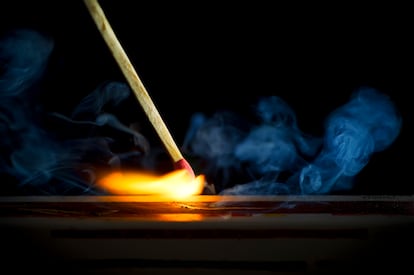Why does a match light up?
To understand the process, one must first comprehend the concept of the ‘fire triangle’

When we observe how a match burns, whether when lighting a gas cooker or something larger, we are looking at a combustion process. To understand how this process works, we need to be familiar with a concept we call the fire triangle. The fire triangle refers to the three elements necessary for combustion to occur. The first is fuel because, when it comes to combustion, matter burns in the presence of an oxidizing agent, releasing energy in the form of heat. The second element is the comburent, which is the oxidizing agent and which is usually oxygen. And the third is a heat source, what we call activation energy, which is what starts the combustion and can be a spark or an electric current.
But not only does combustion have to occur; it must be maintained, which requires a series of chain reactions. Recently, the fire triangle has been altered by a fourth element, and that is why we now call it the fire tetrahedron — tetra is a prefix of Greek origin that means four.
The reason behind the addition of this fourth element lies in the fact that the composition of the first matches to be made has been changed for the better. Also called friction matches, the first examples were devised in the early 19th century and were little more than an object that ignites when rubbed against sandpaper with white phosphorus as the main element. Over time, this white phosphorus was observed to be extremely toxic, causing serious illness, especially in the women and children who worked in the factories where it was produced. At the beginning of the 20th century, it was replaced by red phosphorus, which is what matches now contain.
As well as red phosphorus, matches have other compounds that aid combustion, such as antimony trisulfide, or other sulfur derivatives, which functions as a fuel, and potassium chlorate, or an equivalent oxidizing compound, which releases the oxygen needed for combustion. They also have a number of additives, such as colorants and adhesives, but the key elements are red phosphorus, antimony trisulfide and potassium chlorate. Matches also have the stick, which is usually made of wood and is generally impregnated with a kerosene wax.
Nowadays, for safety reasons, the red phosphorus is not in the head of the match, but in the scraper of the box, and is mixed with glass powder. This prevents the matches from burning inside the box by rubbing against each other.
When we rub the match on the box scraper, we get friction, which is the source of heat necessary for combustion to start. With the heat, a small amount of red phosphorus is transformed into white phosphorus, which ignites and releases energy. The potassium chlorate gives off the oxygen needed for the combustion of the remaining phosphorus and antimony trisulfide, which helps the flame to form. This process initiates combustion in the shape of the ignition of the match head. As the match stick is made of wood, or cardboard, and is impregnated with wax, it keeps the combustion going.
Sign up for our weekly newsletter to get more English-language news coverage from EL PAÍS USA Edition
Tu suscripción se está usando en otro dispositivo
¿Quieres añadir otro usuario a tu suscripción?
Si continúas leyendo en este dispositivo, no se podrá leer en el otro.
FlechaTu suscripción se está usando en otro dispositivo y solo puedes acceder a EL PAÍS desde un dispositivo a la vez.
Si quieres compartir tu cuenta, cambia tu suscripción a la modalidad Premium, así podrás añadir otro usuario. Cada uno accederá con su propia cuenta de email, lo que os permitirá personalizar vuestra experiencia en EL PAÍS.
¿Tienes una suscripción de empresa? Accede aquí para contratar más cuentas.
En el caso de no saber quién está usando tu cuenta, te recomendamos cambiar tu contraseña aquí.
Si decides continuar compartiendo tu cuenta, este mensaje se mostrará en tu dispositivo y en el de la otra persona que está usando tu cuenta de forma indefinida, afectando a tu experiencia de lectura. Puedes consultar aquí los términos y condiciones de la suscripción digital.










































